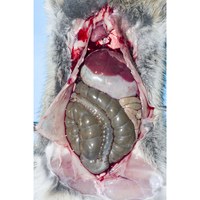Post mortem examination of cases of suspected RHD
Rabbit haemorrhagic disease (RHD) is a disease that can cause rapid and unexpected death. The emergence of a new variant of the disease (RHDV2) has proved to be a cause of sudden death in pet rabbits, even some that have been vaccinated against RHD with Nobivac Myxo/RHD. The vaccine is not fully protective (if at all) against the new variant. New vaccines are becoming available.
The classic post-mortem signs of RHD are blood in the abdomen and splenomegaly but a knowledge of the normal appearance of the abdominal viscera is needed to differentiate between normal and abnormal. The images on the left show the normal abdominal viscera of a young rabbit that died as a result of predator attack. It would be easy to believe this was a case of RHD on cursory examination, but close examination shows a liver and spleen that are normal and the blood in the abdomen is the result of trauma. In cases of RHD, there are usually other signs, inluding hepatomegaly with a mottled appearance to the liver. Illustrations can be found here. There are other diseases that can cause blood in the abdomen (trauma, ruptured liver due to torsion, neoplasia or lipidosis). An apparently large spleen can be a normal feature of young rabbits.
Other conditions that could cause similar changes are septicaemia, heat stroke, hepatic lipidosis or anticoagulant rodenticide poisoning. Histopathology is an important part of establishing a diagnosis. It is advisable to collect samples of liver and spleen that can be stored frozen until the histology results are available. If histopathology results are suggestive of RHD, PCR testing will confirm RHD and differentiate between variants.


